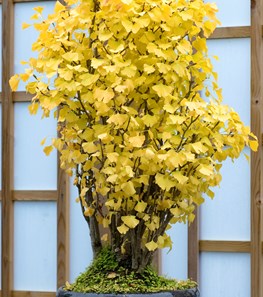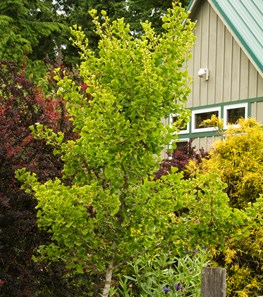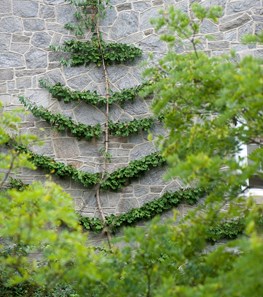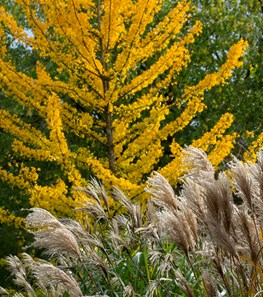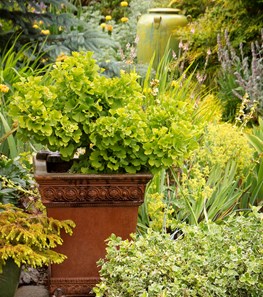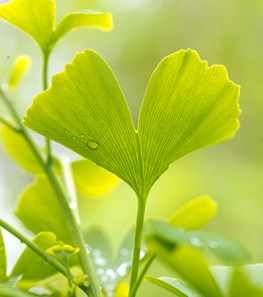Crane says the ginkgo gave him “the perfect opportunity to talk about the work I’ve been doing-evolutionary history, cultural history interactions, and how and where plants stand with people.” He grew up in England, earned a Ph.D. in Botany, and began to learn how interesting and how important the ginkgo is. He recalls a field trip to Yorkshire’s fossil fields with the late Thomas Maxwell Harris, a noted British paleobotanist. Crane’s understated reaction to the 150-million-year-old fossilized leaves of an ancestor of today’s Ginkgo biloba: “Wow, this is an old tree.”
In 1981 Crane came to the U.S. for research and later held positions at the Field Museum of Natural History in Chicago. On a fossil-hunting trip to a treeless area of North Dakota in 1982, a local collector showed him “an exquisitely preserved ginkgo leaf.” The fossil was 57 million years old, and it looked just like a leaf of a modern-day ginkgo.
Crane delved further into ginkgos when he returned to England to serve as director and chief executive of the Royal Botanic Gardens, Kew, from 1999 to 2006. As he says in his book, “During those seven years, the oldest and perhaps the most important ginkgo in the United Kingdom flourished just steps from our family’s home in the garden. We passed it almost every day.” The tree was planted around 1761—European traders had brought ginkgo seeds, seedlings, or cuttings to Europe only a decade or two earlier.
The ginkgo’s amazing survival story goes back more than 200 million years. Crane writes, “Ginkgo is a tree that has persisted, little changed, for these unimaginable eons, and its history is an extraordinary tale of survival against great odds.” Ginkgo’s prehistoric ancestors ranged widely throughout the world, but clearly began to decline about 100 million years ago, becoming confined to limited areas of eastern Asia. Still, it endured despite the cataclysmic events that eliminated the dinosaurs and much other plant life.
Around a thousand years ago, the ginkgo was brought from the wild into temple gardens of China, and was later introduced to Japan and Korea. Crane writes that its medicinal and culinary usefulness allowed it to thrive alongside people. It has even proved resilient to modern city life—including 60,000 ginkgo street trees in New York City—which Crane credits to the tree’s roots’ relative tolerance of compacted soil, its ability to survive with poor air quality, and little oxygen getting to the roots.
Crane explains how one of the ginkgo’s many quirky ways have given it another edge in survival. The tree is relatively unusual among seed-bearing plants in having male and female reproductive parts on separate trees. The female ginkgo produces the famously stinky seeds containing the prized and edible nuts. The trees used for landscaping are usually named varieties of male trees (thus odor-free), selected for their form (from compact ‘Lakeview’ to columnar ‘Princeton Sentry’ to weeping ‘Pendula’) or brilliance of fall color (‘Autumn Gold’). There’s also ‘Variegata’, with cream-and-green variegated leaves.
For his services in research and conservation programs, as well as his leadership at the Royal Botanical Gardens, Kew, Crane was knighted in the U.K. in 2004. Now his main interest is studying living plants with a paleontological history—such as the dawn redwood and the magnolia and its relatives—and what can be learned from them. He worries about the danger to biodiversity because of intense deforestation around the world, with more species becoming extinct now than at any other time in history. Though the ginkgo is a success story—of near extinction and survival—it serves also as a cautionary tale of potential loss. Crane writes that the ginkgo asks us to “think more carefully about all we lose when the short view rules our world and everything in it.”
SIX WAYS WITH GINKGOS
AMAZING GINKGO
Gleaned from Peter Crane’s book and interviews with him, here are just some of the reasons why Ginkgo biloba is one of the most historic, distinctive, interesting—and weirdest—trees.
- Ancient ginkgo relatives date back more than 200 million years, based on fossils found in Asia, Europe, South Africa, Australia, North America, and even the Arctic.
- About a hundred ginkgos in China may approach a thousand years old, and are considered to be the oldest living ginkgos. Many were planted around temples or shrines, where they were protected. The Grand Ginkgo King, in the village of Li Jiawan, is nearly 100 feet tall with a trunk about 19 feet across at ground level.
- Wild ginkgo trees are rare, but ancient ginkgos grow “in what appears to be a more or less wild situation” in China. The best place to see what are thought to be wild trees is Tianmu Mountain National Nature Reserve, 172 miles from Shanghai.
- What is believed to be the oldest living ginkgo in North America (planted in Philadelphia in 1785) was a gift from botanist William Hamilton to naturalist John Bartram. The tree still survives in Bartram’s Garden, a historic site open to the public.
- The best landscape planting, according to Crane, is the double allée of more than 140 beautifully manicured ginkgos, 100 years old, along the so-called “Ginkgo Avenue” of the Meiji Jingu shrine’s outer garden in Tokyo. When the trees are in fall color, “Sightseers come to admire the view, eat roasted ginkgo nuts, and take tea as the late-afternoon light fades away and winter approaches.”
- “Ginkgo has the most synchronized leaf drop of any tree I know,” writes Crane. Poet Howard Nemerov describes the leaf drop: “The golden and green leaves litter the lawn today, that yesterday had spread aloft their fluttering fans of light. What signal from the stars?”
